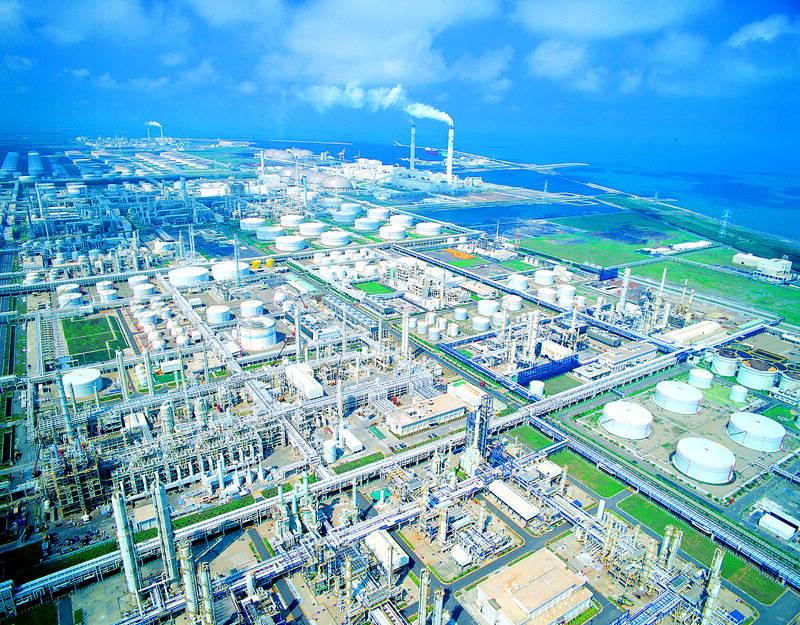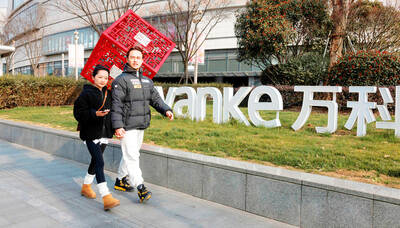The four major units of Formosa Plastics Group (FPG, 台塑集團), the nation’s largest industrial conglomerate, on Wednesday reported their net profits last quarter all fell from the previous quarter due to a decrease in non-operating income and the impact of foreign exchange losses.
This quarter, the four units — Formosa Plastics Corp (台灣塑膠), Nan Ya Plastics Corp (南亞塑膠), Formosa Chemicals and Fibre Corp (台灣化學纖維) and Formosa Petrochemical Corp (台塑石化) — are expected to see their operations affected by low oil prices and weak seasonal demand for oil products, analysts said.
Factors such as soft petrochemical demand amid a slow China recovery, disruption during the Lunar New Year holiday and fierce market competition amid new capacity ramp-up in foreign markets would also weigh on the units’ business performance, they added.

Photo: Taipei Times File Photo
“In the mid-to-long term, we anticipate a weak demand recovery overall, given persistent sector oversupply as China and the US continue to ramp up new capacity,” Yuanta Securities Investment Consulting Co (元大投顧) analysts said in a research note on Thursday. “For this year, with demand to recover as inventory adjustment ends, we expect Formosa Plastics, Nan Ya Plastics and Formosa Chemicals to see sales and earnings improve. However, carbon fee levies from this year will negatively impact earnings.”
During the October-to-December quarter, Formosa Plastics swung into a net loss of NT$2.88 billion (US$92.52 million) due to annual maintenance and demand weakness, as well as narrower investment gains, while Nan Ya Plastics saw its net profit contract 96.8 percent sequentially to NT$140 million on fewer investment gains and higher foreign exchange losses, the companies said in separate regulatory filings.
Formosa Chemicals’ net profit plunged 99.2 percent quarter-on-quarter to NT$574 million, hit by weakened demand and oversupply in China, coupled with narrower investment gains. Formosa Petrochemical’s net profit also fell 91.7 percent to NT$1.43 billion in the past quarter, given a slump in oil prices, narrower refinery and olefin product spreads, and inventory impairment and foreign exchange losses, their filings showed.
The FPG units posted a combined net profit of NT$44.01 billion last year, down 51.2 percent from a year earlier, as their operating income turned from profit to loss amid a negative macroeconomic environment that led to lower product prices and smaller sales volumes.
The four units' combined operating profit plunged 82.7 percent year-on-year to NT$58.96 billion, while revenue fell nearly 18 percent to NT$1.83 trillion compared with a year earlier.
Formosa Plastics, the group’s flagship company, reported its net profit last year fell 79.7 percent from the previous year to NT$7.35 billion, or earnings per share (EPS) of NT$1.15, and Nan Ya Plastics, the nation’s largest plastics maker, saw its net profit drop 80.4 percent to NT$6.31 billion, or EPS of NT$0.8.
Formosa Chemicals, which manufactures aromatics and styrenics, said its net profit grew 15.3 percent to NT$8.49 billion, or EPS of NT$1.45.
Formosa Petrochemical, the nation’s only listed oil refiner, reported its net profit rose 51.6 percent to NT$21.86 billion, or EPS of NT$2.3.

CHIP RACE: Three years of overbroad export controls drove foreign competitors to pursue their own AI chips, and ‘cost US taxpayers billions of dollars,’ Nvidia said China has figured out the US strategy for allowing it to buy Nvidia Corp’s H200s and is rejecting the artificial intelligence (AI) chip in favor of domestically developed semiconductors, White House AI adviser David Sacks said, citing news reports. US President Donald Trump on Monday said that he would allow shipments of Nvidia’s H200 chips to China, part of an administration effort backed by Sacks to challenge Chinese tech champions such as Huawei Technologies Co (華為) by bringing US competition to their home market. On Friday, Sacks signaled that he was uncertain about whether that approach would work. “They’re rejecting our chips,” Sacks

Taiwan’s long-term economic competitiveness will hinge not only on national champions like Taiwan Semiconductor Manufacturing Co. (TSMC, 台積電) but also on the widespread adoption of artificial intelligence (AI) and other emerging technologies, a US-based scholar has said. At a lecture in Taipei on Tuesday, Jeffrey Ding, assistant professor of political science at the George Washington University and author of "Technology and the Rise of Great Powers," argued that historical experience shows that general-purpose technologies (GPTs) — such as electricity, computers and now AI — shape long-term economic advantages through their diffusion across the broader economy. "What really matters is not who pioneers

BUBBLE? Only a handful of companies are seeing rapid revenue growth and higher valuations, and it is not enough to call the AI trend a transformation, an analyst said Artificial intelligence (AI) is entering a more challenging phase next year as companies move beyond experimentation and begin demanding clear financial returns from a technology that has delivered big gains to only a small group of early adopters, PricewaterhouseCoopers (PwC) Taiwan said yesterday. Most organizations have been able to justify AI investments through cost recovery or modest efficiency gains, but few have achieved meaningful revenue growth or long-term competitive advantage, the consultancy said in its 2026 AI Business Predictions report. This growing performance gap is forcing executives to reconsider how AI is deployed across their organizations, it said. “Many companies

China Vanke Co (萬科), China’s last major developer to have so far avoided default amid an unprecedented property crisis, has been left with little time to keep debt failure at bay after creditors spurned its proposal to push back a looming bond payment. Once China’s biggest homebuilder by sales, Vanke failed to obtain sufficient support for its plan to delay paying the 2 billion yuan (US$283.51 million) note due today, a filing to the National Association of Financial Market Institutional Investors showed late on Saturday. The proposal, along with two others on the ballot, would have allowed a one-year extension. All three